Category Archive: Rivet Nuts
Sherex Fastening Solutions’ Optisert, the best performing round body rivet nut on the market, was recently awarded as a winner of the 2023 Fastener Innovation Awards by WorldwideFastenerSources.com.
The innovative Optisert was chosen as a winner because of its incredible performance against spin-out. Its proprietary combination of an engineered knurled body and underhead wedge design helps it grip into the base material to prevent it from spinning. In softer materials, like aluminum, plastics, and composites, the spin-out performance matches that of a full hex body rivet nut.
This award “aims to recognize the people and companies to encourage Research & Development in the fastener industry,” as stated in the release by Mike McGuire, president of WorldwideFastenerSources.com.
“We are proud that the Fastener Innovation Awards are based on technical advancements compared to what exists in the marketplace today,” McGuire was quoted in the release.
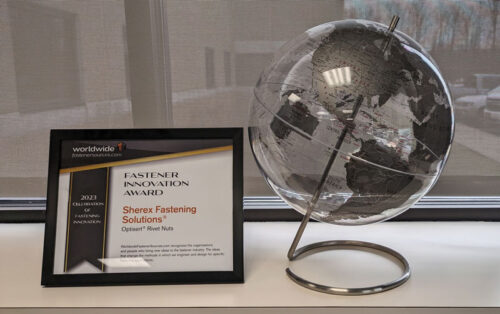
The Certificate of Recognition and Crystal Marquise Globe given to the award winners
This is now the second recognition for Optisert, as it was also a finalist for the Route to Fastener Innovation 2023.
Optisert took over 7 years of research and development to become part of Sherex’s standard part offering. That meant lots of testing and tinkering to make sure Optisert would be ready to perform as a premier round body rivet nut in softer materials.
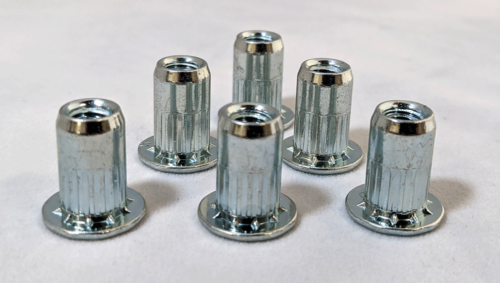
Optisert’s underhead wedges and engineered knurls give it superior grip
“A driving force in the evaluation process is that the fasteners be innovative in assemblies today and that they will become tomorrow’s standard,” the award release said. “Our philosophy is continuous improvement with innovative solutions for customers’ fastening applications.”
Sherex shares the same philosophy and with more innovations coming soon, more awards should be on the way!
Hi all! This year seemed to be the year when the COVID pandemic was clearly in the rearview mirror. We launched the best-performing round body rivet nut, Optisert (which customers love), traveled to see our great customers more than ever, and came up with some great solutions for our customers to solve difficult fastening problems.
Optisert Buzz Is Growing
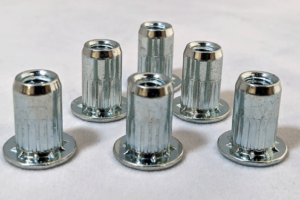
Optisert’s diamond wedges and engineered knurls creates incredible spin-out resistance
While saying Optisert is the best-performing round body rivet nut may sound like marketing talk, we have the data to back it up. Now, we have the customers too. Many assemblers made the switch to Optisert, and one chose the new round body standard over a potential, and costly, change to a hex body rivet nut too.
The benefit is simple: Optisert’s spin-out performance in composite, plastics, carbon fiber, aluminum, and other softer materials is as great as a hex body rivet nut. Spin-out resistance is critical in many applications, and round body rivet nuts have had significantly less spin-out resistance than hex body rivet nuts. Now, if OEMs can’t produce a hex hole, they can feel confident that Optisert can deliver the performance they expect from a threaded fastener.
We’ve seen Optisert in automotive, heavy truck, and general industrial applications with more projects on the way.
Solutions for Heavy Trucks and Construction and Agriculture Equipment
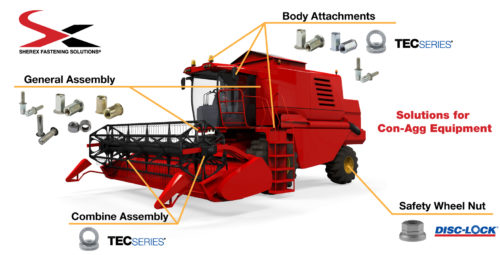 We’ve added two new industry pages and a solutions for composite page that highlight some of the most popular and best practice fasteners for the application.
We’ve added two new industry pages and a solutions for composite page that highlight some of the most popular and best practice fasteners for the application.
The Fastener Solutions for Heavy Trucks, Fastener Solutions for Construction and Agriculture Equipment and Fastener Solutions for Composite Materials pages are designed for OEMs and distributors to think about the applications they have and how the joint can be secured better or assembled better. Use the products other assemblers are using in your own to save money and decrease waste.
While many of these our products are standard rivet nut products in our catalog, others are custom solution fasteners designed specifically for the application. Our engineering team will work directly with the OEM to find a solution that is the best performing, cost effective, and makes it easier on assemblies.
Sherex President Adam Pratt Presentation at IFE
Sherex President Adam Pratt had the opportunity to present at IFE and talked about a variety of topics, including how rivet nut fasteners are ideal replacements for weld nuts. The talking points in all of these snippets are great and useful when talking about Sherex products or rivet nut fastening in general.
Take a look at the videos below:
Weld Nuts vs. Rivet Nuts
Sherex Optisert with Installation Data!
Sherex RIV-FLOAT
Why Assemblers Need and Calibration Unit
Benefits to Using Process Monitoring
More Innovations to Come!
Like our Optisert round body rivet nut – Sherex has a few more “game-changers” in the hopper that assemblers will love to get their hands on. As Adam Pratt said in his presentation at IFE, Sherex will always try to innovate and push assemblers to use the best fastener for the application. And with more products to come, that means better fasteners and better applications.
In our last blog post, we discussed compression limiters, their usage, and their benefits. However, there is an even simpler solution available: combining a compression limiter with a rivet nut to create a compression limiting rivet nut.
A compression limiting rivet nut integrates both a rivet nut and a compression limiter into a single piece with a unique part number.
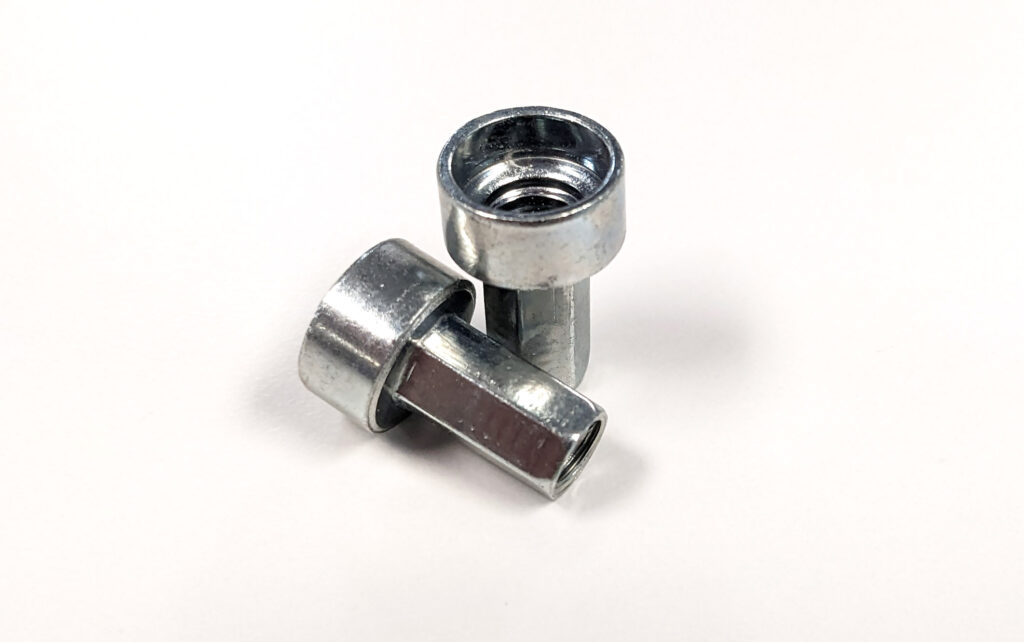
Example of a Compression Limiting Rivet Nut
This part offers several advantages:
1. It is a single component instead of two separate parts. This streamlines assembly time and simplifies the ordering process for purchasers, as they only need to consider one part.
2. It is cost-effective. A compression limiter and a rivet nut combined would likely cost more than a specially designed compression limiting rivet nut.
How does it work?:
With a compression limiting rivet nut, it pretty much acts as a rivet nut with a bigger shoulder or spacer combined on top of the rivet nut. When the compression limiting rivet nut installs, it installs into the base material, but the spacer or compression limiter then sits above it as to not distort the material sitting on top.
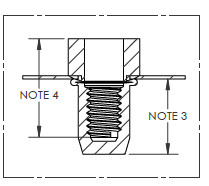
Top half is the compression limiter, bottom half rivet nut!
Like all compression limiters made and designed by Sherex, they are all unique to the application and the same applies with these compression limiting rivet nuts. They are very popular in automotive applications with pretty much limitless designs: round body, hex body, underhead seals, knurls, ect. Sherex engineering works with the application design engineers to come up with a design that will surpass performance expectations while also being the most cost-effective solution compared to other fastening options.
So, if considering a compression limiter, a compression limiting rivet nut might be the solution you need!
Compression limiters are typically cylindrical components made of steel, stainless steel, brass, or aluminum that prevent overstressing of usually plastic or composite material and fastener clamp load loss during fastener installation. They can be used integrated with a fastener, such as a rivet nut, to provide metal to metal transfer of forces during the joint assembly.
This helps to prevent the surrounding material from being deformed or damaged.
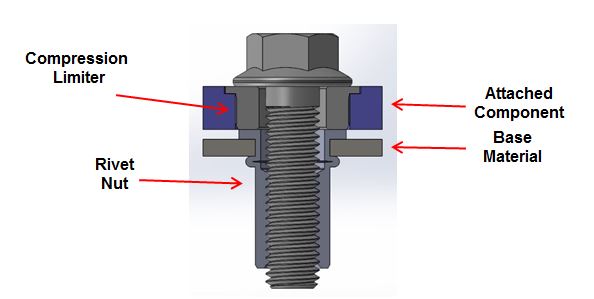 Essentially, the compression limiter can fill a gap for a metal on metal load transfer as to not deform the material. So when the fastener, such as a screw or bolt, is tightened, the compression limiter is compressed between the fastener head and the metal parts being joined for a compact assembly.
Essentially, the compression limiter can fill a gap for a metal on metal load transfer as to not deform the material. So when the fastener, such as a screw or bolt, is tightened, the compression limiter is compressed between the fastener head and the metal parts being joined for a compact assembly.
The designs of a compression limiters are limitless. They can very large or very small, have knurls or wedges, or just be a smooth body cylinder like a spacer. What all compression limiters have in common, though, is that they are UNTHREADED. In some scenarios a bolt may pass through the compression limiter, it doesn’t have threads to keep the bolt in place.

What applications are compression limiters used in?
Metal compression limiters are commonly used in industries such as automotive, aerospace, construction and agricultural equipment, and in general construction where high strength and reliability are crucial. They are often used in applications where the joint must withstand significant loads or stresses, such as in structural connections or engine components. They are oftentimes used to not distress the base material.
How they are made?
Compression limiters are either cold-formed or machined. Sherex engineers design compression limiters for specific applications, so many of these parts are unique to the project they were designed for.
Sherex makes hundreds of thousands of compression limiters every year out of its Sherex Akron facility in Akron, Ohio. To learn more about compression limiters or if in of a compression limiter for your application, contact us!
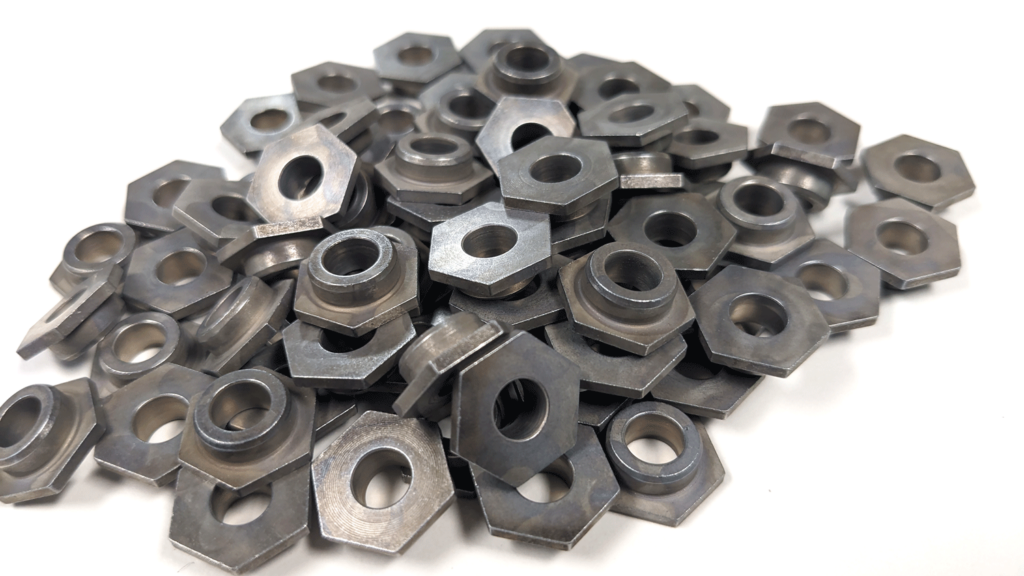
It’s recommended that if manufacturers and assemblers can create a hex hole, using a hex body rivet nut is the best way to attach a joint together.
But what if you’re using a fastener automation system? Is a hex body rivet nut the best rivet nut to use when installing them automatically through an automation installation system?
Probably not. Especially now with Optisert available.
With high volume installations of rivet nuts, automation is a best practice method. It’s faster than human installation, installations are perfect (and if they’re not the system will let you know), and it doesn’t need a human to install the rivet nuts. But when using a hexagonal hole to install hex body rivet nuts using automation, this is where things get tricky.
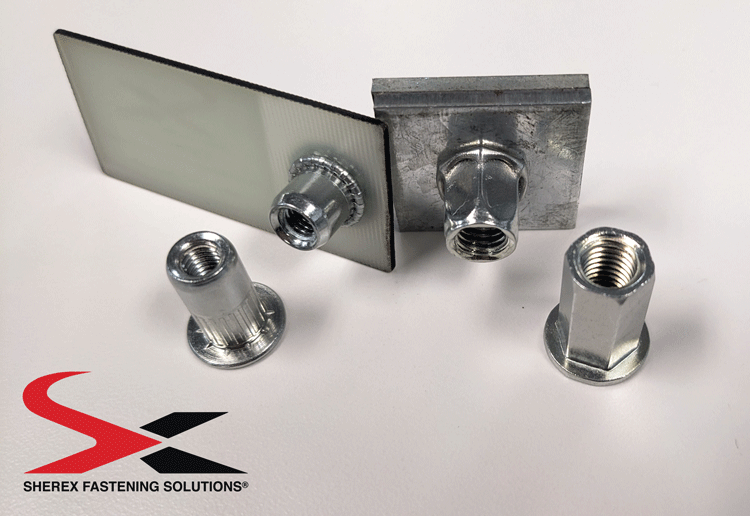
Optisert vs. Hex Body Rivet Nut
The automation feeder needs to be able to line up the points of the hex body rivet nut with the points of the hex body hole, perfectly. It’s not ideal, but possible through more expensive automation equipment. With a round body rivet nut into a round hole, there’s no need to worry about the points lining up… because, well, there’s no points on a round body rivet nut or a round hole!
Oh yeah, but what about performance?
So yes, hex body rivet nuts are recommended. It’s the best rivet nut at resisting spin-out. BUT, Optisert can hold its own. Its performance metrics are greater than a half hex body style rivet nut, and more similar to a full hex body style rivet nut in some base materials (softer materials like plastic, composite, aluminum). Plus, Optiserts are less expensive than full hex body style rivet nuts.
So when deciding between full hex rivet nuts and round body rivet nuts for automation, rivet nut performance might not be the first criteria. Ease of installation for the automation system to run efficiently will be a high priority. With Optisert’s performance similar to a hex body rivet nut, and it being a round body, Optisert might very well be the best rivet nut option for automation on the market today.
It’s a little brash, but Sherex has the data to back it up: we’re calling Optisert the best round body rivet nut based on performance.
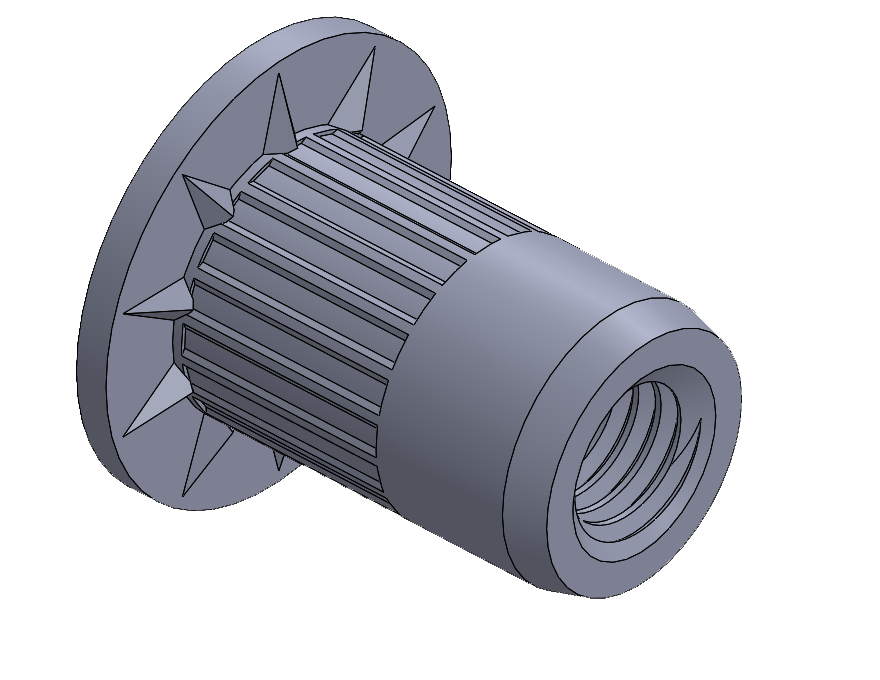 Sherex has been working for over five years on a round body rivet nut that can perform comparably vs. a half hex body rivet nut. This rivet nut can do that.
Sherex has been working for over five years on a round body rivet nut that can perform comparably vs. a half hex body rivet nut. This rivet nut can do that.
We are still going to recommend a full hex body rivet nut if you can make a hex hole – especially in harder material like steel and stainless steel. But if a round hole is the only hole that can be produced, especially in softer materials like plastic, fiberglass and aluminum, Optisert’s performance is impressive.
“We’ve had over five years of product development to get the performance where we want it,” said Sherex Engineering Manager John Knechtges. “We’ve done similar wedgehead, knurled rivet nuts as specials for projects, but this standard part has unmatched performance. We’re really proud.”
Let’s look at the numbers:
Optisert vs. CAL Series and CAL Wedge round body:
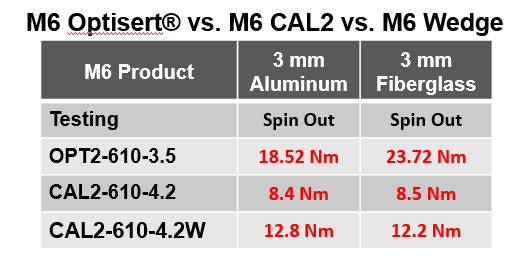
Optisert vs. Half Hex:
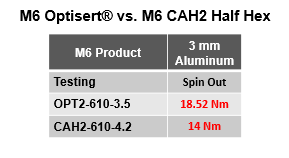 The numbers speak for themselves. Optisert spin-out performance is closer to the performance of a full hex rivet nut than a normal, round body CAL rivet nut, and GREATER than a half hex rivet nut.
The numbers speak for themselves. Optisert spin-out performance is closer to the performance of a full hex rivet nut than a normal, round body CAL rivet nut, and GREATER than a half hex rivet nut.
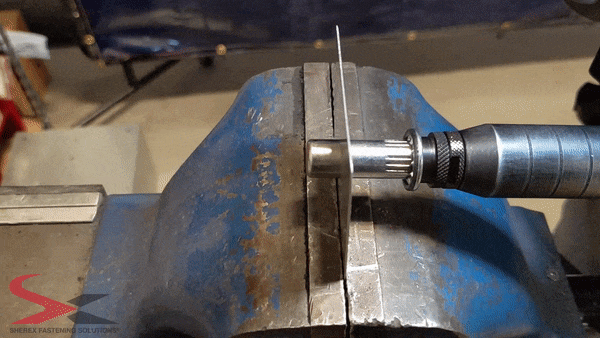 With knurls underneath the flange that bite into the material, resistance to spin out is very extraordinary. Spin-out occurs when the rivet nut spins into the hole it’s installed into. Spin-out would potentially occur in applications that experience heavy vibration, or in applications that experience a lot of strain and force.
With knurls underneath the flange that bite into the material, resistance to spin out is very extraordinary. Spin-out occurs when the rivet nut spins into the hole it’s installed into. Spin-out would potentially occur in applications that experience heavy vibration, or in applications that experience a lot of strain and force.
For industries that are continuously looking for lightweighting options, like automotive and heavy truck, Optisert is an ideal option for a threaded insert fastener. Optisert also comes in a closed end option with a seal that comes standard. The seal does not compromise grip, and helps keep dust and water out of the base material.
What a year!
It was great getting back to some normalcy. But with getting back to normal and ramping up came with challenges many manufacturers ran into this year: SUPPLY CHAIN. With that said, we feel we navigated supply chain issues better than our competitors and we even made moves that will hopefully mitigate those risks in the future.
Let’s take a look at some of the highlights from Sherex this year!
Operators LOVE our Calibration Unit and our Process Monitoring Units
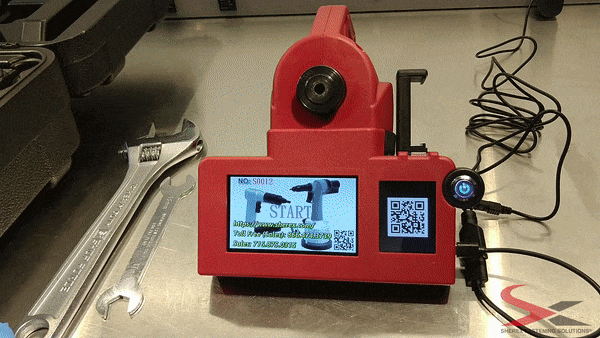
Sherex’s Hand Tool Calibration Unit
When we released our Hand Tool Calibration Unit in 2020, we knew this would be a great tool for any installer. And after two years, we keep getting glowing praise. We hate to toot our own horn, but the tool is awesome. There are so many features the tool can provide, like exporting historical data, showing the recommended installation force on Sherex rivet nuts, and even graphing those recommended forces on to calibration unit to make sure the tool is inside of those parameters. By periodically checking the force of any spin-spin or spin-pull tool, you’ll feel confident the tool is operating how you want it, decreasing the guessing game on the pulling force, waste, and rework.
Some of our automotive tiers have had dozens of our FLEX-5 Process Monitoring Tools installed this year. Sherex Process Monitoring Tools let operators know if the rivet nut installation was perfect, instantly. Sherex sets the tool up to determine if the install was correct based on a variety of parameters: hole size, material, material thickness, rivet nut, rivet nut size, pulling force of the tool, etc. When all those parameters qualify, the system reads it as a good installation. This kind of tool combines quality and efficiency, and lets OEMs know, with data, that installations were perfect or not OK. These tools are perfect for high volume installations like on an assembly line and meets the process monitoring requirement many auto manufacturers require.
Our customers have nothing but great things to say on both these quality tools – you must try them if you haven’t already!
Sherex Poland and Sherex UK locations are off and running
We opened Sherex Poland last year and Sherex UK in 2019 and both locations have been building trust and supplying millions of our quality rivet nuts, threaded inserts, clinch nuts, wedge locking products and tools throughout Europe.
These locations serve as engineering, sales, customer support and warehousing for Europe, bringing us closer to our European customers and therefore, decreasing the total length of our supply chain. This year, new customers were pleasantly surprised we had stock AND could ship quickly! Great year by both Sherex Poland and Sherex UK.
Sherex Akron gets big upgrades, improving supply chain
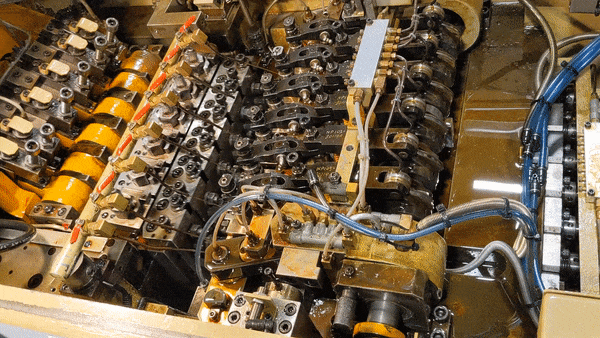
New Part Former Machine at Sherex Akron
Sherex Akron, located in Akron, Ohio, makes all of our aerospace and Department of Defense parts, along with millions of other parts for a variety of other industries, put online two new part formers that as part of Sherex’s global capacity plan. These cold formers have allowed us to diversify the products we make in Akron while decreasing lead times. Akron still is capable of doing many short run jobs, but these part formers will really help with some of the major projects we’ve won throughout the year. Look for lot more product coming out of Akron in the future!
Have a Made in America requirement? Keep Sherex Akron in mind!
Optisert® is coming…
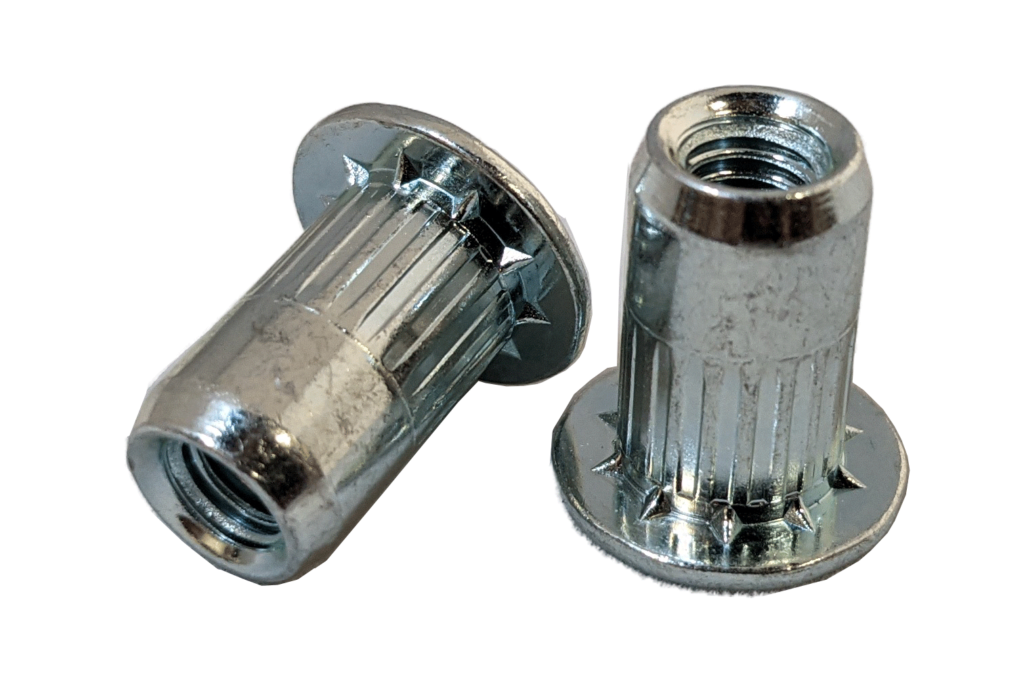
Sherex’s Optisert Rivet Nut
We’ve been talking about it for quite some time, but now it’s ready to be released. Sherex’s new round body rivet nut, Optisert, is set to be released in early 2023. Once released, Optisert will be the best performing round body rivet nut on the market. The combination of knurled body and underhead wedges give it superior strength when installed in softer material — its performance matches and in some cases is greater than a hex body rivet nuts!
This will be the “New Standard” when it comes to round body rivet nut and performance. Stay tuned!!
Look for more industry specific content in the future
You know Sherex has Solutions for EV Automakers, but we also have solutions for Construction and Agriculture, Aerospace, Heavy Truck, Renewable Energy, and more.
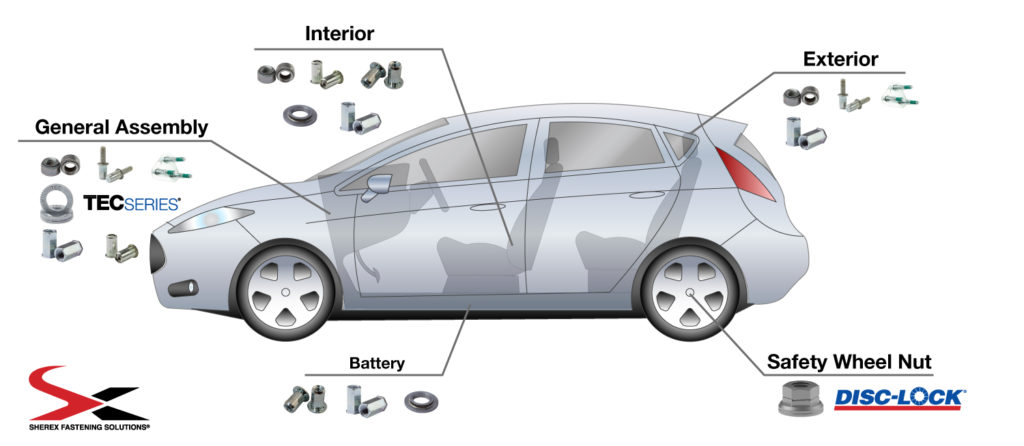 Keep a look out for some of that industry specific content to show how Sherex can help make applications in all industries get assembled easier and perform better.
Keep a look out for some of that industry specific content to show how Sherex can help make applications in all industries get assembled easier and perform better.
These are some of highlights this year and our strategy going into 2023 and beyond.
Overall, Sherex had a strong year and we’re proud of our team to make that happen. One thing that will never change is our desire to find a solutions to your fastening problem. Customer service is key to our success, and we promise to provide the engineering and customer support you need from design, to manufacture, to assembly!
We wish everyone a happy holiday and best wishes in 2023.
What do you need to be successful at installing rivet nuts? Depends who you ask.
For some, it’s just parts and a rivet nut tool. But it really should be more than that.
Let’s take a look at what every rivet nut installer should have at his or her rivet nut workstation:
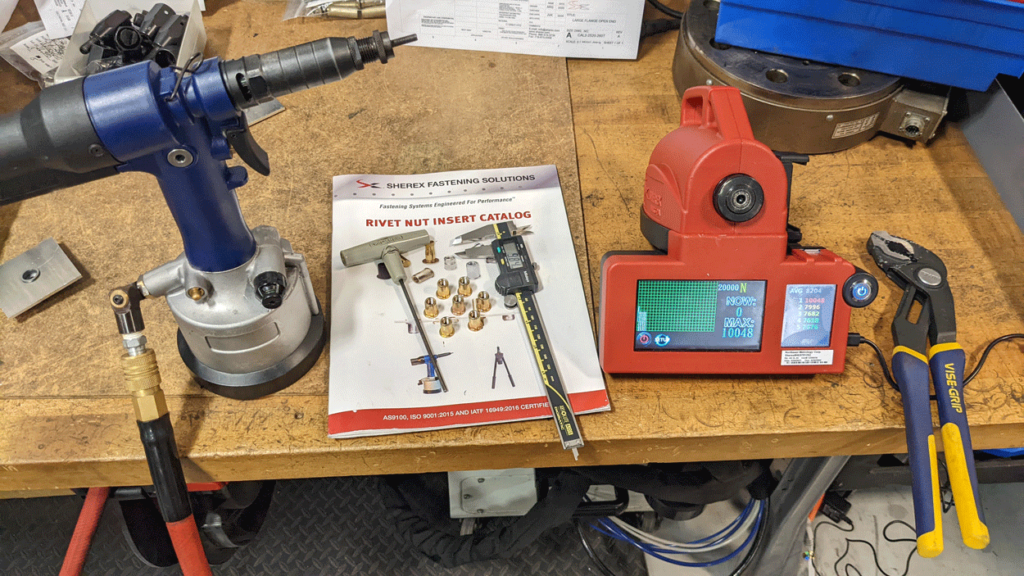
Hand Tool Calibration Unit
Unless you’re installing parts with a process monitoring tool, you need a Hand Tool Calibration Unit. The Hand Tool Calibration Unit shows the pulling force of the rivet nut installation tool, so users know the exact installation force being used to install the part. A dip in pulling force may set the part improperly, leading to rework and time spent fixing parts the user already installed.
Calipers
Every fastener installer needs calipers at their workstation. Calipers are used to measure the dimension and length of an object. This could be the measurement of the hole, or the installed length of the rivet nut. They help ensure the part was installed correctly too.
Rivet Nut Catalog
The rivet nut catalog has loads of information the user may need during their installations. Everything from grip range, installation length, hole size, part number nomenclature and more. It’s a valuable reference to make sure you’re installing the correct part.
Hex Tool
Hex tool is used to increase or decrease the pressure on your hydro-pneumatic rivet nut tool. By using the Hand Tool Calibration Unit to check the pressure, you’ll know whether to turn the pressure up or down on your rivet nut tool.
Vice Grips
Vice Grips are used to install the headset on the Hand Tool Calibration Unit and change the headset on your tooling.
Rivet Nut Tooling
It goes without saying, you need rivet nut tools to install rivet nuts. There are a variety of fastener installation systems you can use, but preferably it would be a hydro-pneumatic tool as it offers fast installation with the ability to spin the part onto the mandrel itself.
Rivet Nuts
Can’t install rivet nuts without… rivet nuts!
The last two items are pretty obvious, but the others are really necessary to ensure a perfect installations. The Cal Unit so you know the pulling force, the calipers to make sure measurements are to spec, Rivet Nut Catalog to see specs of the part you’re installing, hex tool to change the pressure of the tool, and vice grips to change the mandrel of the Cal Unit. Oh, and you know, rivet nuts and rivet nut tool.
All this will make for some successful installations!
 Sherex makes a variety of NAS/MS round body rivet nuts for the US Aerospace and Department of Defense (DoD) industries out of its Sherex Akron manufacturing facility in Akron Ohio.
Sherex makes a variety of NAS/MS round body rivet nuts for the US Aerospace and Department of Defense (DoD) industries out of its Sherex Akron manufacturing facility in Akron Ohio.
As one could imagine, the Aerospace Industry is highly regulated and guided by a variety of certifications and standards that must be adhered to for performance and safety. Sherex Akron is an ISO 9001:2015, QSLM Class 3 and Class 2 certified through the Defense Logistics Agency, and AS9100 compliant. Sherex’s CAGE Code is 7EK30. What does this mean? Our facility and parts have been qualified and meet a certain criteria required by US aerospace manufactures and the DoD. Manufacturers can be sure the parts they receive live up to the high standards required by these associations.
Remember, these parts not only have to hold the plane together, they have to do so while under harsh conditions, like gravity, pressure, turbulence, and vibration. They must be have high tensile strength and have high corrosion resistance while typically being lightweight.
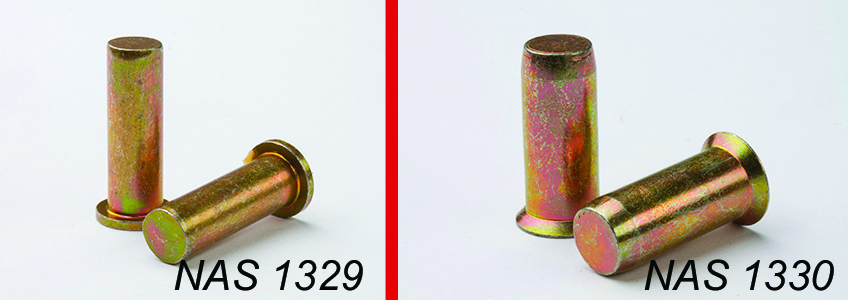
Sherex NAS 1329 and NAS 1330 parts are used in a variety of airplanes and helicopter applications.
Sherex SX aerospace rivet nuts are made of a variety of materials like steel, stainless steel or aluminum, and they are usually round body style with either a flat head (NAS 1329) or countersunk head (NAS 1330). Most of these parts, especially those made of aluminum, are cold formed, so heat is not needed to produce these pieces. Aluminum is not only lightweight, but is resistant to fatigue and features high tensile strength.
Sherex NAS 1329 and 1330 rivet nuts are supplied to a variety of aerospace and DoD manufacturers, including helicopter manufactures. Almost all of applications of Sherex NAS/MS style rivet nuts belong in the cabin and are not considered critical components (like holding the wings onto planes, or landing gear), but nonetheless play an extremely important role in the fuselage and cockpit. One specific application went in the floor of a military helicopter keeping armor together on the floor, and another NAS rivet nut went in the overhead compartment of one of the most popular commercial jet liners ever built.
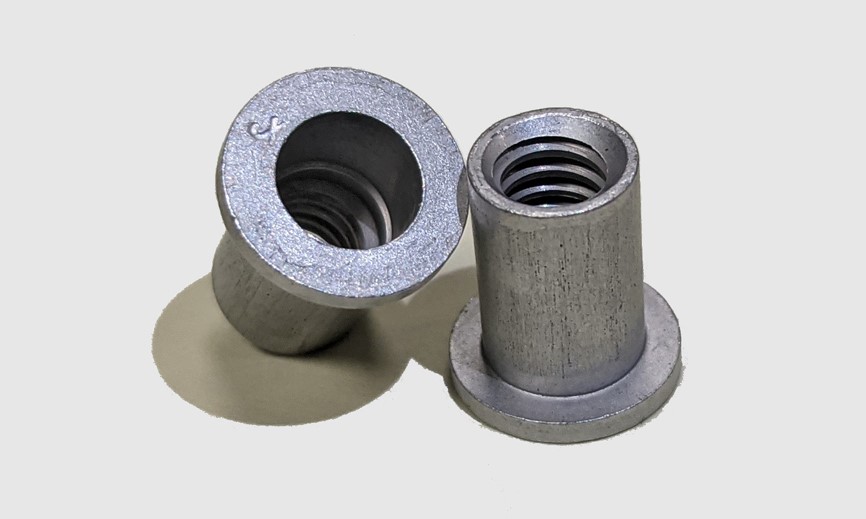
Aluminum NAS1329 Style Rivet Nuts
Sherex has a number of ongoing projects with the DoD and other Aerospace manufactures and has lots of experience in this industry. To learn more about our Akron capabilities, see our DoD Statement of Capabilities and how we can provide extremely quality, and durable fasteners for any aerospace project.
A major benefit of rivet nuts are the variety of styles. Well not to be outdone, clinch nuts also come in a few standard styles that each have its own benefits.
Let’s take a look at different styles of clinch nuts:
ACN Series – High Strength Clinch Nut

ACN Clinch Nut
On this clinch nut, there are displacement lobes that force the sheet metal to flow into the locking groove when pressed in. This allows sheet metal to remain flat with no indentation and providing the nut with high push out and torque values. The base material remains flush.
This style of clinch nut is designed for thicker sheet metal applications from 2mm to 10mm thick, and is compatible with Class 8, 9, & 10 hardware depending on application requirements.
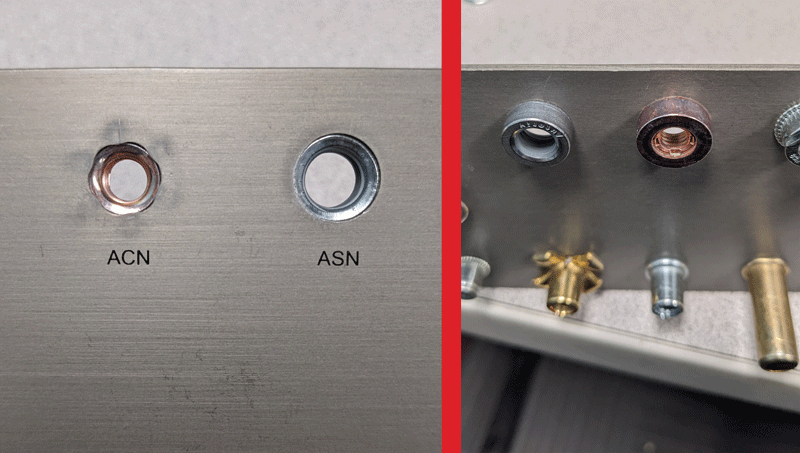
Front and backside of installed ACN and ASN Clinch Nuts. Notice the flush installation on the front side.
PHOTO: How Clinch Nuts are Installed>>
VIDEO: Installing a Clinch Nut with a FLEX-18>>
ASN Series — Serrated Style Clinching Nut Series

ASN Clinch Nut
This clinch nut has extensive knurls that push into the material. During installation, sheet metal is formed into an undercut section on the nut collar by the die button and the knurled ring. As a result, the nut has high push out and torque values, and space requirement is minimal due to the small outer diameter and flat installation surface.
The ASN clinch nut can be used in sheet metal applications from 1.5mm to 10mm thick, and is compatible with Class 8, 9, & 10 hardware depending on application requirements.
ARN Series – Universal Clinch Nut
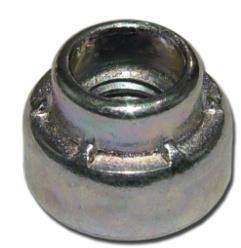
ARN Clinch Nut
The ARN Series clinch nut is a unique style of clinch nut that has locking grooves to dig into the material when pressed in, while the neck part of the clinch nut is crimped over the base material using a special die, making the base material “almost flush.” Locking grooves are the clinch feature of the nut, providing high push out, pull through, and torque values, even in very thin sheet materials. The nut can be installed using several different installation methods depending on the sheet material thickness, hardness, and installation clearance.
Can be used in sheet metal from 0.4mm to 6mm thick, and is compatible with Class 8, 9, & 10 hardware depending on application requirements.
Custom Clinch Nuts
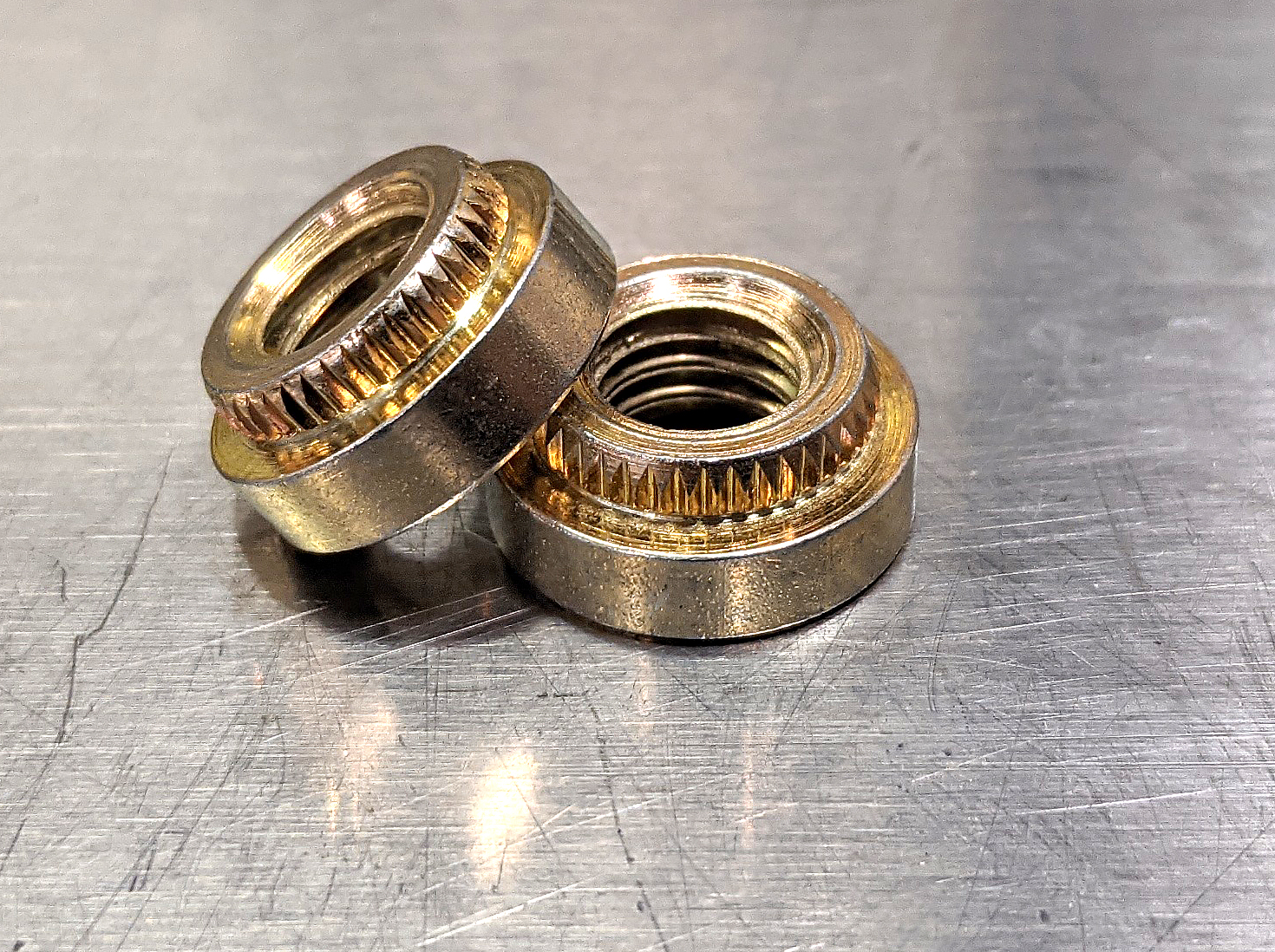 Some projects that require clinch nuts might need a higher tolerance grip range, or something that can bite into the material more, or a different coating. Sherex can design-in and manufacture special clinch nuts for your project. Be sure to look at our post Rivet Nuts vs Clinch Nuts to read the differences and similarities between the two fasteners!
Some projects that require clinch nuts might need a higher tolerance grip range, or something that can bite into the material more, or a different coating. Sherex can design-in and manufacture special clinch nuts for your project. Be sure to look at our post Rivet Nuts vs Clinch Nuts to read the differences and similarities between the two fasteners!
If considering a clinch nut for your project and want to discuss what the best clinch nut for your project will be, contact us!


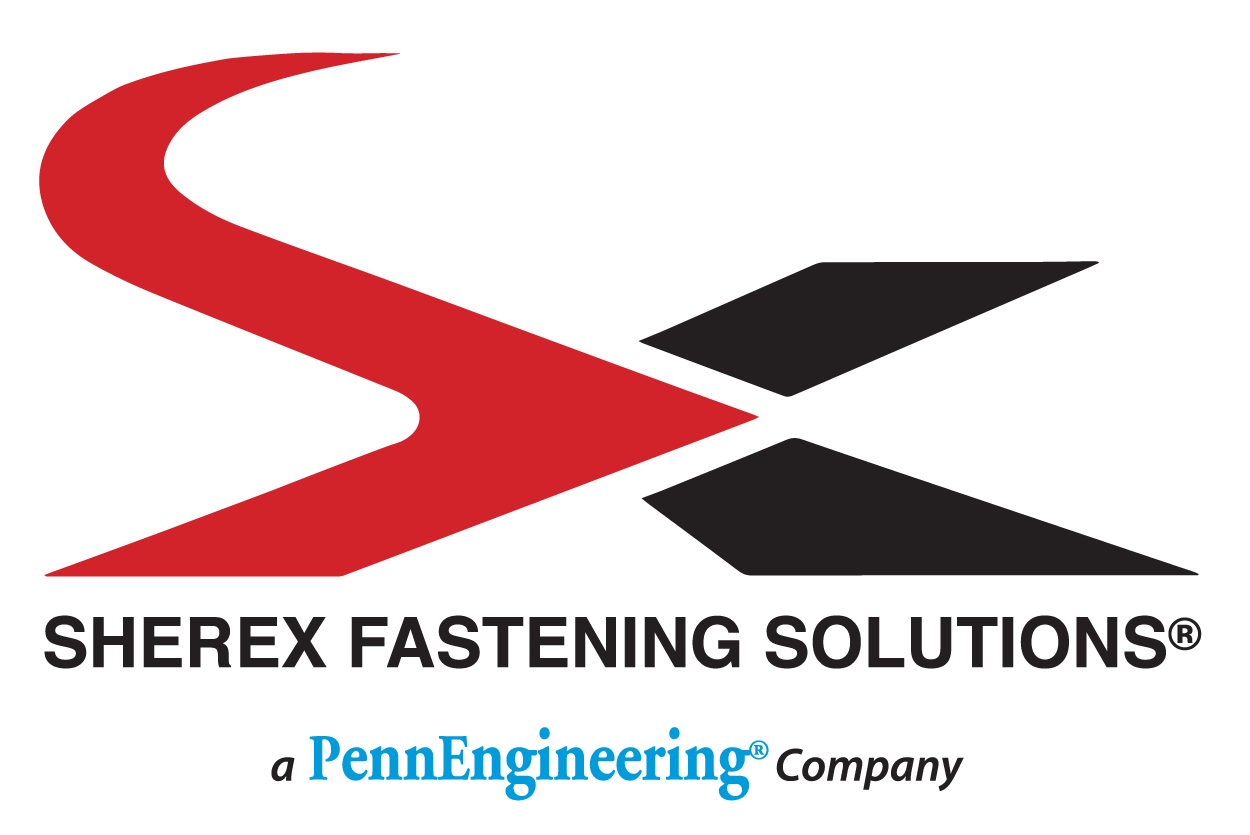






 We’ve added two new industry pages and a solutions for composite page that highlight some of the most popular and best practice fasteners for the application.
We’ve added two new industry pages and a solutions for composite page that highlight some of the most popular and best practice fasteners for the application.

 Essentially, the compression limiter can fill a gap for a metal on metal load transfer as to not deform the material. So when the fastener, such as a screw or bolt, is tightened, the compression limiter is compressed between the fastener head and the metal parts being joined for a compact assembly.
Essentially, the compression limiter can fill a gap for a metal on metal load transfer as to not deform the material. So when the fastener, such as a screw or bolt, is tightened, the compression limiter is compressed between the fastener head and the metal parts being joined for a compact assembly.


 Sherex has been working for over five years on a round body rivet nut that can perform comparably vs. a
Sherex has been working for over five years on a round body rivet nut that can perform comparably vs. a 
 The numbers speak for themselves. Optisert spin-out performance is closer to the performance of a full hex rivet nut than a normal, round body CAL rivet nut, and GREATER than a half hex rivet nut.
The numbers speak for themselves. Optisert spin-out performance is closer to the performance of a full hex rivet nut than a normal, round body CAL rivet nut, and GREATER than a half hex rivet nut. With knurls underneath the flange that bite into the material, resistance to spin out is very extraordinary. Spin-out occurs when the rivet nut spins into the hole it’s installed into. Spin-out would potentially occur in applications that experience heavy vibration, or in applications that experience a lot of strain and force.
With knurls underneath the flange that bite into the material, resistance to spin out is very extraordinary. Spin-out occurs when the rivet nut spins into the hole it’s installed into. Spin-out would potentially occur in applications that experience heavy vibration, or in applications that experience a lot of strain and force.




 Sherex makes a variety of
Sherex makes a variety of 





 Some projects that require clinch nuts might need a higher tolerance grip range, or something that can bite into the material more, or a different coating. Sherex can design-in and manufacture special clinch nuts for your project. Be sure to look at our post
Some projects that require clinch nuts might need a higher tolerance grip range, or something that can bite into the material more, or a different coating. Sherex can design-in and manufacture special clinch nuts for your project. Be sure to look at our post